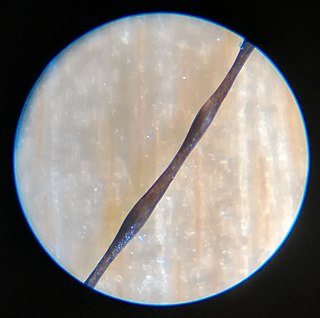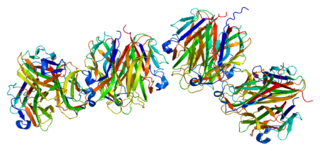Related Research Articles

Keratin is one of a family of structural fibrous proteins also known as scleroproteins. Alpha-keratin (α-keratin) is a type of keratin found in vertebrates. It is the key structural material making up scales, hair, nails, feathers, horns, claws, hooves, and the outer layer of skin among vertebrates. Keratin also protects epithelial cells from damage or stress. Keratin is extremely insoluble in water and organic solvents. Keratin monomers assemble into bundles to form intermediate filaments, which are tough and form strong unmineralized epidermal appendages found in reptiles, birds, amphibians, and mammals. Excessive keratinization participate in fortification of certain tissues such as in horns of cattle and rhinos, and armadillos' osteoderm. The only other biological matter known to approximate the toughness of keratinized tissue is chitin. Keratin comes in two types, the primitive, softer forms found in all vertebrates and harder, derived forms found only among sauropsids.

Keratin, type I cytoskeletal 4 also known as cytokeratin-4 (CK-4) or keratin-4 (K4) is a protein that in humans is encoded by the KRT4 gene.

Keratin 14 is a member of the type I keratin family of intermediate filament proteins. Keratin 14 was the first type I keratin sequence determined. Keratin 14 is also known as cytokeratin-14 (CK-14) or keratin-14 (KRT14). In humans it is encoded by the KRT14 gene.

Keratin 12 is a protein that in humans is encoded by the KRT12 gene.

Keratin 9 is a protein that in humans is encoded by the KRT9 gene.

Keratin, type I cytoskeletal 17 is a protein that in humans is encoded by the KRT17 gene.

Keratin 16 is a protein that in humans is encoded by the KRT16 gene.

Palmoplantar keratodermas are a heterogeneous group of disorders characterized by abnormal thickening of the stratum corneum of the palms and soles.

Pleiotropy occurs when one gene influences two or more seemingly unrelated phenotypic traits. Such a gene that exhibits multiple phenotypic expression is called a pleiotropic gene. Mutation in a pleiotropic gene may have an effect on several traits simultaneously, due to the gene coding for a product used by a myriad of cells or different targets that have the same signaling function.

Monilethrix is a rare autosomal dominant hair disease that results in short, fragile, broken hair that appears beaded. It comes from the Latin word for necklace (monile) and the Greek word for hair (thrix). Hair becomes brittle, and breaks off at the thinner parts between the beads. It appears as a thinning or baldness of hair and was first described in 1897 by Walter Smith

Frizzled-3(Fz-3) is a protein that in humans is encoded by the FZD3 gene.

Frizzled-4(Fz-4) is a protein that in humans is encoded by the FZD4 gene. Fz-4 has also been designated as CD344.

Ectodysplasin A (EDA) is a protein that in humans is encoded by the EDA gene.

Fibroblast growth factor 5 is a protein that in humans is encoded by the FGF5 gene.

Keratin, type I cuticular Ha1 is a protein that in humans is encoded by the KRT31 gene.

Keratin, type II cuticular Hb6 is a protein that in humans is encoded by the KRT86 gene.

Geranylgeranyl pyrophosphate synthase is an enzyme that in humans is encoded by the GGPS1 gene.

Forkhead box protein N1 is a protein that in humans is encoded by the FOXN1 gene.
Keratinases are proteolytic enzymes that digest keratin.

The Frizzle is a breed of chicken with characteristic curled or frizzled plumage. While the frizzle gene can be seen in many breeds, such as the Pekin and Polish, the Frizzle is recognised as a distinct breed in a number of European countries and Australia. In the United States frizzled chickens are not considered a breed, and at shows are judged by the standards of the breed they belong to.
References
- ↑ Liu Y, Snedecor ER, Zhang X, Xu Y, Huang L, Jones EC, Zhang L, Clark RA, Roop DR, Qin C, Chen J (January 2016). "Correction of Hair Shaft Defects through Allele-Specific Silencing of Mutant Krt75". The Journal of Investigative Dermatology. 136 (1): 45–51. doi:10.1038/JID.2015.375. PMC 4764097 . PMID 26763422.
- ↑ Ng CS, Wu P, Foley J, Foley A, McDonald ML, Juan WT, Huang CJ, Lai YT, Lo WS, Chen CF, Leal SM, Zhang H, Widelitz RB, Patel PI, Li WH, Chuong CM (2012). "The chicken frizzle feather is due to an α-keratin (KRT75) mutation that causes a defective rachis". PLOS Genetics. 8 (7): e1002748. doi: 10.1371/journal.pgen.1002748 . PMC 3400578 . PMID 22829773.